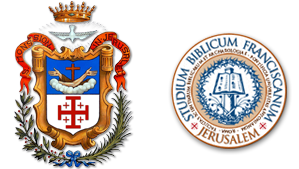...................................
[read in Italian] ![]()
Who has cupped in his hand the waters of the sea,
and marked off the heavens with a span?
Who has held in a measure the dust of the earth,
weighed the mountains in scales
and the hills in a balance?
(Is 40, 12)
In November 2022 St. Saviour’s monastery in Jerusalem hosted the exhibition Witness to the Resurrection. The Basilica of the Holy Sepulchre described in the books (15th-20th centuries) of the Library of the Custody of the Holy Land in Jerusalem, whose catalogue is available online. It was made possible thanks to some students from the Catholic University of Sacred Heart (and some other friends) who collaborated in the project “Books Bridges of Peace”, started by CRELEB of Catholic University and Pro Terra Sancta. Its goal is to promote the heritage of the General Library of the Custody of the Holy Land: its ancient book collection, preserved by Franciscans in Jerusalem. As suggested by its name, this project believes that thanks to this material – exhibited, explained, photographed – it is possible to build cultural and amicable relationships which can nurture knowledge, respect and relations between the different communities living today in the territories of the Holy Land (divided among many countries and national authorities) and especially in Jerusalem (see the series of catalogues of the exhibitions held from 2014 to 2023 on the website of the library).
And indeed the exhibition on the Holy Sepulchre – which drew inspiration from the on-going floor restoration of the Basilica – promoted the interest in books about the history of ancient religious buildings erected in the places of Jesus’ life. Of course, though these identifications may sometimes be questioned, they are almost always based on very ancient traditions, on the one hand, and on the other they often rely on archaeological studies which confirm their authenticity. Among these books, whether pilgrims’ descriptions or scholars’ reports, one stands out: Trattato delle piante et imagini de i sacri edificii di Terra Santa disegnate in Gierusalemme (“Treatise on the Plans and Drawings of the Sacred Edifices of the Holy Land done in Jerusalem”) by the Franciscan Bernardino Amico, who not only first measured the sacred buildings using scientifical criteria at the end of 16th century, but was also able to reproduce their elevations and sections in perspective, like a true modern architect. Moreover, the existence of two different editions of this work (1609 and 1620) makes this story even more fascinating (see their descriptions in APHL Digital Library. A Bibliography of Travels to the Holy Land, a bibliographic and catalographic project close to the end).
Bernardino Amico’s work has recently been at the heart of different studies hopefully properly used here (see the bibliography): a precious contribution came from both the edition of the Trattato by Bellarmino Bagatti translated into English (Jerusalem, Franciscan Printing Press, 1953 = 1997) and the facsimile of the 1620 edition published in Nardò by Fondazione Terra d’Otranto in 2016.
Hopefully this digital exhibition will not only promote one of the most exceptional architectural books of the Italian 17th century, but also the great work of a scholar of the Holy Land.*
Jerusalem, 2nd February 2023, Feast of the Presentation of Jesus at the Temple
* Please note: the 1609 edition is quoted using the page number for the text and the plate number for the illustrations, while the 1620 edition is quoted using the signature of its gatherings (fol. B1r, fol. Ee2v, etc.) for the text and the plate number for the illustrations. When possible, the English version is taken from the translation by Theophilus Bellorini and Eugene Hoade contained in the aforementioned volume edited by Father Bagatti (hereinafter referred to as “Plans”). In some passages we took the liberty to slightly modify the translation.
When the captions do not mention the work the picture was taken from, the image comes from Bernardino Amico’s Trattato. Date of edition in brackets.
